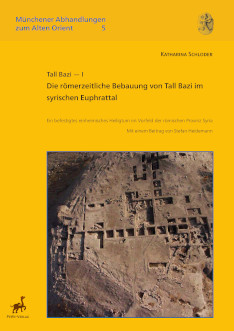MAAO-5 Katharina Schloder
The site of Tall Bazi, located on the left bank of the Euphrates in modern Syria, is especially known for its Bronze Age sanctuary and settlement. However, remains of a more recent settlement dating to the 2nd century AD covered the Late Bronze Age levels. They were excavated by a team from LMU Munich, studied by Katharina Schloder as part of her PhD thesis, and are here published as the first volume of the final publications of the excavations at Tall Bazi.
The Roman site of Tall Bazi consisted of a fortified sanctuary with an irregular layout. One of the buildings can be interpreted as the central sanctuary unit. Based on the evidence of stratified finds, we can date the construction of the sanctuary to the late 1st or early 2nd century AD. It remained in use until the second half of the 2nd century AD. The comprehensive assessment of the structures and finds enables us to pursue questions concerning the cultic actions, building techniques and form of the temple. Also the identities of the founder and of the visitors to the sanctuary are discussed. Beyond that the function of Tall Bazi in its political-cultural setting is analysed. Crucial for these questions is its geographic position lying inside the kingdom of Osrhoene between Rome and Parthia.
Comparable ritual sites have not been identified in the Near and Middle East. The publication of this singular site on the border between the Roman and Parthian Empires is therefore of utmost importance.
MAAO-5 (Münchener Abhandlungen zum Alten Orient, Volume 5)
Katharina Schloder
Tall Bazi – I. Die römerzeitliche Bebauung von Tall Bazi im syrischen Euphrattal. Ein befestigtes einheimisches Heiligtum im Vorfeld der römischen Provinz Syria.
2019, PeWe-Verlag, Gladbeck
352 pp., 71 text-figures, some in colour, 100 tablet and 5 folded maps
30 x 21 cm — hardcover
Price: € 65.00 [D]
ISBN: 978-3-935012-37-9


